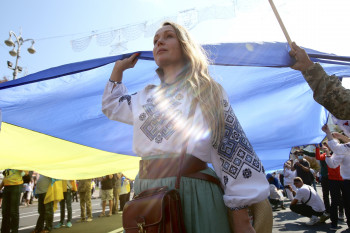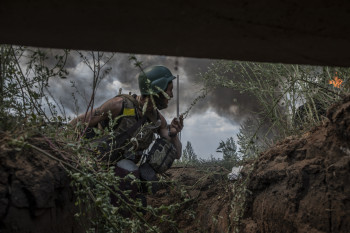Ukraine's victories from Kyivan Rus to 2022 Battle of Kyiv

As Ukraine marks its Independence Day amid some of the most dangerous and terrible moments in the country’s history, some may succumb to despair.
But if Ukraine's history teaches something, it is that there is always a silver lining. The ongoing full-scale Russian war isn’t the first time Ukraine faces an existential challenge, and history shows us that the country and its capital have always stood tall.
Ukraine – in different forms and under different names – has survived for over a millennium. Ukraine has stood firm under its blue and yellow banner amid numerous external attempts to destroy the country, obliterate its culture, and kill its people.
Ukraine was always fighting back, protecting its distinct culture.
The Kyiv Independent is looking at some of Ukraine's major political and military victories and cultural achievements starting from the founding of the proto-Ukrainian state – Kyivan Rus, in the mid-9th century – to the successful counteroffensive near Kyiv in March-April 2022.

Kyivan Rus
Kyivan Rus, a predecessor state of Ukraine founded in the 9th century, was one of the largest and most powerful political entities in Europe. Rus, with its capital in Kyiv, controlled territory stretching from the Baltic Sea to the Black Sea.
Rapidly expanding during the next few centuries, the proto-Ukrainian state won numerous battles, often against seemingly more powerful enemies.
One of the most bellicose Kyiv princes was Svyatoslav, who ruled in the 10th century. Under the prince’s command, the state delivered a final blow to the Khazar Khaganate – a large Turkic state that controlled territory from modern-day Moldova to the Caspian Sea.
Yet military victories were not the only achievements of Kyivan Rus.
The state was fully integrated into European culture and politics. The so-called Ruthenian princes married into Western European and Byzantine royal families.
The most famous example of such ties was the marriage of Anna of Kyiv, the daughter of prince Yaroslav the Wise, to Henry I, king of the Franks.
The political institutions of Kyivan Rus also resembled those of western Europe. Power was divided between princes and popular assemblies, which were called viche. The state also produced a legal code - the so-called Ruska Pravda (Rus’ Justice), drafted in the 11th and 12th centuries.
The monumental architecture of ancient Rus was among the most advanced in Europe. The 11th-century Saint Sophia сathedral in Kyiv rivaled its namesake in Constantinople. The reconstructed cathedral remains one of the key landmarks of independent Ukraine.

Galicia-Volhynia
After the disintegration of the Kyivan Rus and subsequent Mongol invasion, the Principality of Galicia-Volhynia became the main independent proto-Ukrainian state comprising modern western Ukraine.
Its most prominent prince, Danylo Romanovych, was the only Ukrainian ruler in ancient Rus who maintained some autonomy from the Mongols, although he had to pay homage to them.
In an effort to secure support against the Mongols, he sought an alliance with the West and was crowned as the king of Ruthenia by the Holy See in 1253.
In 1256, King Danylo founded one of Ukraine’s main cities – Lviv, named after his son Lev.
Danylo also interfered directly in European politics. His son Roman married an Austrian heiress and claimed the rights to the duchy of Austria.
Grand Duchy of Lithuania
Although founded by Lithuanians in the 13th century, with the political center being Vilnius, the Grand Duchy of Lithuania's legacy is equally shared by Ukrainians and Belarusians.
Between the 14th and 16th centuries, the Ruthenian language – which later developed into Ukrainian and Belarusian – was the duchy's predominant tongue, while the Ruthenian culture dominated the realm.
Ruthenian aristocracy married into the Lithuanian elite, while many Lithuanian noblemen switched to Ruthenian after acquiring land in modern Ukraine and Belarus.
The Western-oriented Lithuanian Rus was the main rival of the Grand Duchy of Moscow, which was acquiring land under Mongol patronage.
The Grand Duchy of Lithuania spanned from the Baltic Sea to the Black Sea, including Belarus, Ukraine, and parts of modern Russia. Ruthenian troops, including those from modern-day Ukraine and Belarus, took part in the landmark Lithuanian victory over the Golden Horde at Blue Waters in 1362 and the historic 1410 Battle of Grunwald, in which Poland and Lithuania defeated the Teutonic Knights.
After the grand duchy merged into the Polish-Lithuanian Commonwealth in 1569, Kyiv remained a major cultural center, and the Kyiv Mohyla Academy became one of the key gateways for arts and sciences.
Cossacks
The most significant string of Ukrainian victories is linked to the creation and preservation of the so-called Zaporizhzhian Sich and the Cossack Hetmanate, quasi-independent stratocracies run by Ukrainian military men known as the cossacks.
In 1648, Bohdan Khmelnytsky, a Ukrainian nobleman turned military chief, led a successful uprising against the Polish-Lithuanian Commonwealth, establishing the Hetmanate. Led by a military chief known as the Hetman, the Ukrainian cossacks became a major regional force until the late 18th century, fighting along different states.
One of their most prominent military leaders was Hetman Petro Sahaidachny, famous for attempting to seize Moscow together with Polish-Lithuanian troops in 1618.
Despite the attempt being unsuccessful, the campaign resulted in a peace treaty under which Russia ceded a portion of its territory to the Polish-Lithuanian Commonwealth.
In line with European tradition, the Hetmanate and the Zaporizhzhian Sich were republics with popular assemblies and elected leaders. The cossacks would go on to elect their hetmans, while the lack of unity among the militarized people resulted in internal conflict.
The hetmans were also known for supporting Ukrainian art and culture. During the time of Hetman Ivan Mazepa, many Eastern Orthodox churches were built in what is now known as the Ukrainian Baroque, or Cossack Baroque.
In 1710, exiled Hetman Pylyp Orlyk wrote one of Europe's first constitutions, which established the separation of powers and limited the hetman's authority. Although the constitution has never been enforced due to the Russian conquest of Ukraine, it is cherished as the country’s first written constitution.
Despite the cossacks’ demise, the Hetmanate period has been credited with leading to the birth of modern Ukrainian literature and theater, as well as the standard Ukrainian literary language in the 18th to 19th centuries.
The founders of modern Ukrainian literature include Ivan Kotlyarevsky, Taras Shevchenko, Lesya Ukrainka, and Ivan Franko.

Fight for statehood
Entering the 20th century, Ukrainians faced famine, torture, and mass executions, while trying to successfully establish an independent state. Despite all the struggles, Ukraine succeeded.
Ukraine’s first attempt came in 1917 after two Russian revolutions triggered the creation of the Ukrainian People's Republic with Kyiv as the capital. A year later, the Western Ukrainian People's Republic was proclaimed, with two states formally uniting in January 1919.
Ukrainian forces were fighting against the much larger Russian armies until 1921, when they were eventually suppressed by Soviet Russia.
Despite failing to preserve Ukrainian independence, Ukrainian troops under the command of Simon Petlura helped protect Poland from a Soviet invasion, taking part in the Kyiv Offensive and the 1920 Battle of Warsaw.
In 1921, the Soviet Union and Poland divided Ukrainian lands among themselves after signing the Peace of Riga. Ukrainians didn’t stop the fight.
Looking for ways to achieve independence and preserve the Ukrainian language, religion, and culture, two political projects were created in western Ukraine – the moderate Ukrainian National Democratic Alliance (UNDO) and the more radical Organization of Ukrainian Nationalists (OUN).
The latter wasn’t shy of attempting to achieve Ukrainian independence with arms, establishing the Ukrainian Insurgent Army (UPA) in 1942, tasked with fighting against Poland, the Soviet Union, and Nazi Germany.
As some Ukrainians were fighting for the country’s independence within UPA’s ranks, many were fighting alongside the Soviet army. An estimated 9 million Ukrainians died during World War II.

Independence
Despite initially failing to achieve independence, Ukrainians didn’t stop the fight, reaching the long-awaited goal in 1991.
Yet simply gaining freedom isn’t enough, preserving the achieved independence is the goal Ukraine is still fighting for.
Unlike its northern neighbors – Russia and Belarus – the people of Ukraine have fought to maintain a democratic, law-based society where the freedom of speech and thought is unquestionable.
It took three revolutions to consolidate this victory – the 1990 Granite Revolution, the 2004 Orange Revolution, and the 2014 EuroMaidan Revolution.
A number of significant flaws are still present – corrupt judiciary, nepotism, and a weak and overregulated economy. Yet, Ukraine has been steadily moving towards Europe and its values, becoming an EU candidate country in 2022.
Russia’s war
However, as Ukrainian history has shown, an independent and successful Ukraine needs to be preserved on the battlefield. And now Ukraine is once again fighting to preserve its independence.
Afte creating an army almost from scratch in 2014, Ukrainian troops liberated Kramatorsk, Sloviansk, and Mariupol from Russian-led troops during the initial stages of Russia’s war against Ukraine.
Ukrainian resistance in 2014 guaranteed the survival of the Ukrainian state and stalled Russian advances in the Donbas.
Eight years later, after Russia launched its all-out invasion on Feb. 24, many predicted that Kyiv would fall within days, and Ukraine would eventually collapse.
However, Ukraine stood firm, with the country’s highly motivated and combat-ready Armed Forces and the Territorial Defense Forces, consisting mostly of volunteers, defeated the outnumbering Russian forces near Kyiv, in Chernihiv and Sumy oblasts by early April.













